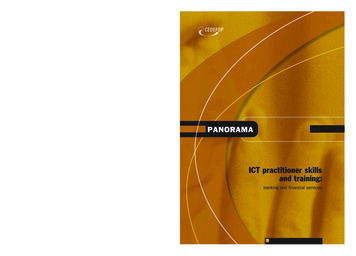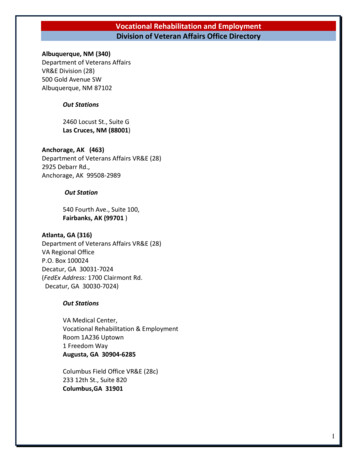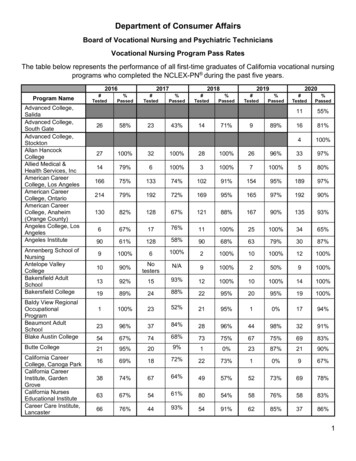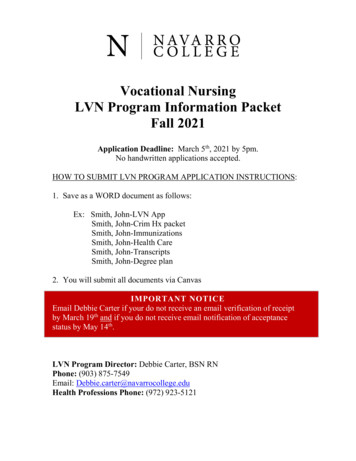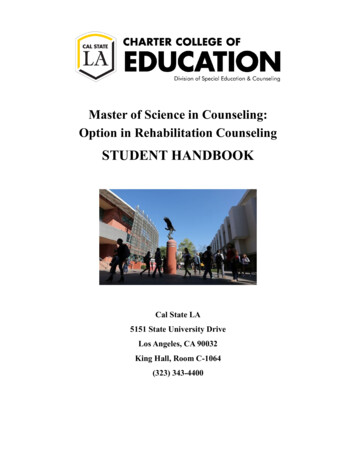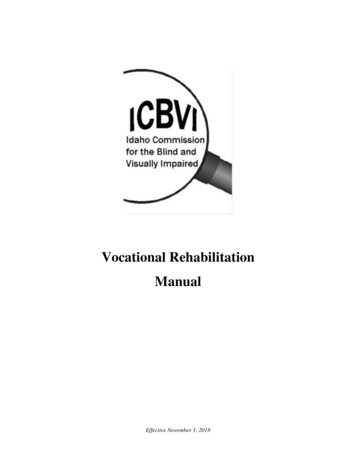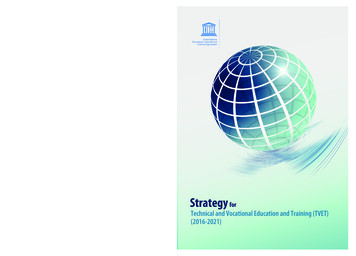
Transcription
United NationsEducational, Scientific andCultural OrganizationStrategy forEducationSectorUnited NationsEducational, Scientific andCultural OrganizationFor more information, please visit:www.unesco.org/educationTechnical and Vocational Education and Training (TVET)(2016-2021)
Published in 2016 by the United Nations Educational, Scientific and Cultural Organization7, place de Fontenoy, 75352 Paris 07 SP, France UNESCO 2016Cover illustration: Baseline Arts and UNESCOInside illustrations: Designed by UNESCO-UNEVOC/A. MejiaSource:Earth Vector - Creative Commons 3.0 vecto2000 http://vecto2000.com/earth-vector/ (edited in composition)Flat urban landscape and building vector 03 – Creative Commons 3.0 welovesolohttps://www.welovesolo.com/?s flat urban (edited in composition)Designed and printed by UNESCOPrinted in FranceED-2016/WS/24
UNESCO Strategy forTechnical and Vocational Education and Training (TVET) 2016-2021The strategy aims to:support the efforts of Member States to enhance the relevance of their TVET systems and to equip all youth andadults with the skills required for employment, decent work, entrepreneurship and lifelong learning, andcontribute to the implementation of the 2030 Agenda for Sustainable Development as a whole.Did you know that.475 1.447340million youth currentlyunemployed and themillion new annualentrants to thelabour market.1billion workersworldwide are invulnerableemployment.2“Attainingdecent work isa significantchallenge foryouth.“million new jobs need tobe created to absorb the“Despiteprogress andeconomicgrowth,inequalitiesand povertypersist in manyparts of theworld.For all countries,climatechangerepresents an urgentand potentiallyirreversible threatthreat.By contrast, the poorest10% earn around 2% ofthe total income.315-60millionnew jobscould be generated globally overthe next two decades throughthe transition to agreenereconomy.5VSThe globalunemployment rate (%)The global labour forceparticipation rate (%)46.4 5.768.7 81.7““Over the nextdecade, at leastOn average, for countries inwhich data is available, thewealthiest 10% earn 30-40%of the country's total income.“Rising youth unemployment isone of the most significantproblems facing economiesand societies in today’s world,for developed and developingcountries alike.All Member States havepriorities for transition togreen economies andclimate resilient societies.3 Pillars of Priority AreasFostering youth employment andentrepreneurshipUNESCO will supportMember States toconduct Policyreviews and TVETreformsUNESCO willmobilize cooperationof differentstakeholdersUNESCO will supportMember States todesign efficient andeffective TVETfunding strategiesPromoting equity andgender equalityUNESCO willconduct policyadvice andcapacity-buildingprogrammesUNESCO willpromote targetedpolicy measures fordisadvantagedgroupsFacilitating the transition to greeneconomies and sustainable societiesUNESCO willpromote greenskills for a smoothtransition togreeningeconomiesUNESCO willencourageexchange anddisseminationof knowledgeUNESCO willfostercross-sectoralapproaches ofTVETUNESCO will supportmeasures enhancingwomen’s and girls’access to relevantTVET programmesand providing equalopportunities in theworld of workUNESCO willsupport MemberStates to leveragedigital technologiesand close the digitaldivideTo maximise the outcomes of the Strategy’s priority areas, UNESCO will help Member States:to identify and anticipateskills requirements to informTVET policies, strategies andprogrammes and to createmulti-level and multi-sectoralstakeholder platforms1 - ILO: World Employment and Social Outlook: Trends 20152 - ILO: Research News 1/2015by facilitating the debate onrecognition of skills andqualifications, including acrossborders, as well as buildinglearning pathways in a lifelonglearning perspective3 - ILO: World Employment and Social Outlook: Trends 20154 - ILO: Global Employment Trends 2014in monitoring progresstowards SDG4 andrelated TVET targetswith a framework of keyindicators5 - ILO: Working Towards Sustainable Development 2012Designed by UNESCO-UNEVOC/A. Mejia
Strategy forTechnical and Vocational Education and Training (TVET)(2016-2021)I. CONTEXT1.The international community has set an ambitious 2030 Agenda for Sustainable Develop ment. It calls for an integrated approach to development which recognises that eradicatingpoverty in all its forms and dimensions; combating inequality within and among countries;preserving the planet; creating inclusive and sustainable economic growth; achieving fulland productive employment and decent work for all women and men; and ensuring fullgender equality and fostering social inclusion, are interdependent.2.Education and training are central to the achievement of the 2030 Agenda. The vision ofthe Incheon Declaration: Education 2030 is fully captured by Sustainable DevelopmentGoal 4 “Ensure inclusive and equitable quality education and promote lifelong learningopportunities for all”. Education 2030 devotes considerable attention to technicaland vocational skills development, specifically regarding access to affordable qualityTechnical and Vocational Education and Training (TVET); the acquisition of technical andvocational skills for employment, decent work and entrepreneurship; the elimination ofgender disparity and ensuring access for the vulnerable. In this context, TVET is expectedto address the multiple demands of an economic, social and environmental nature byhelping youth and adults develop the skills they need for employment, decent work andentrepreneurship, promoting equitable, inclusive and sustainable economic growth, andsupporting transitions to green economies and environmental sustainability.3.In the last six years, UNESCO implemented a Strategy for TVET1 (2010-2015) which aimedat strengthening support to Member States to improve their TVET policies and systems.The Shanghai Consensus,2 adopted in 2012 at the Third International Congress on TVET,provided a vision to connect the analysis of TVET systems with intended developmentoutcomes, and indicated key recommendations for TVET system reform and policydevelopment.12See: 7e.pdfSee: pdfSTRATEGY FOR TECHNICAL AND VOCATIONAL EDUCATION AND TRAINING (TVET) (2016-2021)4
54.The vision and policy areas of the Shanghai Consensus helped to inspire the revision anddrafting of the Recommendation concerning Technical and Vocational Education andTraining (2015), which was developed in close coordination and synergy with the newlyrevised Recommendation on Adult Learning and Education (2015). Both Recommendationsprovide impetus for work in the field of lifelong learning and are crucial to accompanythe implementation of Education 2030.5.An evaluation of the Strategy3 was conducted in 2014-2015. UNESCO’s work was found tobe widely appreciated. UNESCO’s expertise in providing policy advice, capacity-buildingand conducting policy reviews is valued at the national level, while its conceptual andnormative work constitute a specific added value that helps Member States to set up andimprove their TVET policies and systems. The evaluation further highlighted UNESCO’sglobal leadership role in positioning TVET as a learning path that contributes to equity,social justice, lifelong learning and sustainable development. The evaluation furtheracknowledged the uniqueness of the global UNEVOC Network4 of TVET institutions as wellas UNESCO’s convening power in bringing together international organizations that areactive in TVET. A number of challenges were also identified regarding the effectivenessand sustainability of UNESCO’s activities at the country level, including the absence of alonger-term strategic approach. Despite the acknowledged advances, achieved throughthe revamping of the UNEVOC Network since 2010, the evaluation concluded thatthe Network’s potential needs to be more fully realized.6.The development of this new Strategy for TVET has taken into account the 2030 Agenda,the Education 2030 Framework for Action, the evaluation of the Strategy for TVET (20102015), the Recommendation concerning TVET (2015), UNESCO’s analysis of global trends inTVET5, and various consultations, such as a virtual conference on the new Strategy organizedby the UNESCO-UNEVOC International Centre and meetings of the Inter-Agency Groupon TVET on skills in the 2030 Agenda. The consultation and drafting process took placein coordination with the development of the Education 2030 Framework for Action (FFA).This is intended to ensure that the implementation of the Strategy for TVET and the FFAwill mutually address key TVET policy issues, in particular youth employment, decent work,entrepreneurship and lifelong learning.345See: 2E.pdfSee: http://www.unevoc.unesco.org/go.phpSee: 0e.pdfSTRATEGY FOR TECHNICAL AND VOCATIONAL EDUCATION AND TRAINING (TVET) (2016-2021)
II. OBJECTIVE AND PRIORITY AREAS7.The Strategy sets out key policy areas and actions for the period 2016 to 2021 withinthe framework of the Medium Term Strategy (37 C/4). It contributes to UNESCO’s strategicobjectives, the Organization’s global priorities for gender equality and Africa, the GlobalAction Programme on Education for Sustainable Development and the OperationalStrategy on Youth.8.Within this context and in full alignment with SDG4 to “Ensure inclusive and equitablequality education and promote lifelong learning opportunities for all”, the Strategy aimsto support the efforts of Member States to enhance the relevance of their TVET systemsand to equip all youth and adults with the skills required for employment, decent work,entrepreneurship and lifelong learning, and to contribute to the implementation ofthe 2030 Agenda for Sustainable Development as a whole.9.The Strategy has three priority areas:(1)Fostering youth employment and entrepreneurship;(2)Promoting equity and gender equality;(3)Facilitating the transition to green economies and sustainable societies.1.Fostering youth employment and entrepreneurship10.Rising youth unemployment is one of the most significant problemsfacing economies and societies in today’s world, for developed anddeveloping countries alike. At least 475 million new jobs need to becreated over the next decade to absorb the 73 million youth currentlyunemployed and the 40 million new annual entrants to the labour market6.At the same time, OECD surveys7 suggest that both employers and youthconsider that many graduates are ill-prepared for the world of work. Attainingdecent work is a significant challenge. In many countries, the informal sectorand traditional rural sector remains a major source of employment. The number ofworkers in vulnerable employment currently stands at 1.44 billion worldwide8. Workers insub-saharan Africa and South Asia account for more than half this number, with three outof four workers in these regions subject to vulnerable employment conditions.6See: ts/---dcomm/---publ/documents/publication/wcms 337069.pdfSee: http://www.enterprisesurveys.org/; 789264234178-en.htmSee: ts/---inst/documents/publication/wcms 346619.pdf78STRATEGY FOR TECHNICAL AND VOCATIONAL EDUCATION AND TRAINING (TVET) (2016-2021)6
11.TVET can equip youth with the skills required to access the world of work, including skillsfor self-employment. TVET can also improve responsiveness to changing skill-demands bycompanies and communities, increase productivity and increase wage levels. TVET canreduce access barriers to the world of work, for example through work-based learning,and ensuring that skills gained are recognised and certified. TVET can also offer skillsdevelopment opportunities for low-skilled people who are under- or unemployed, out-ofschool youth and individuals not in education, employment and training (NEETs).12.UNESCO will continue providing evidence-based and impact-oriented advice forinterventions at the national level, and through regional and global initiatives whereappropriate. At the national level, UNESCO will support TVET policy reviews and policydevelopment and in-depth analysis of specific priority areas, including funding. Additionally,UNESCO will support capacity-building initiatives of national decision-makers andinstitutions responsible for the training of teaching of staff and managers. At the regionallevel, UNESCO will support the emergence of regional TVET agendas, peer learning andknowledge sharing. At the global level, UNESCO will encourage and support multilateralinitiatives and collaborative activities that promote the transformation and attractiveness ofTVET worldwide as a contribution to youth employment, decent work and entrepreneurship.Supporting policy reviews and policy development713.UNESCO will promote a whole-of-government approach toTVET transformations that foster youth employment and betterconnect and align relevant policy areas, including but notlimited to education, employment, industrial and economicdevelopment, agriculture and rural development, health, andsocial policy. Interventions will be demand-driven, and willbe planned, designed, implemented and evaluated in fullalignment with the development context and policy priorities inthe beneficiary countries.14.Support to TVET policy reviews and policy development will be based upon key policy lines,indicated in the Recommendation concerning TVET (2015) which include, among others,institutional arrangements, gover nance and regulatory frameworks, funding, equity andaccess (particularly for marginalised groups and women), quality and relevance, curriculareform, qualification frameworks and quality assurance, the professional development ofteaching staff, and the monitoring and evaluation of TVET strategies and programmes.15.UNESCO will support Member States to ensure their TVET policies promote the developmentof entrepreneurial skills, through strategies such as incorporating courses in entrep reneur ship into formal curricula and certification, supporting small businesses in providingworkplace training and stimulating the creation of incubators and co-operative projectswith the private sector and communities.STRATEGY FOR TECHNICAL AND VOCATIONAL EDUCATION AND TRAINING (TVET) (2016-2021)
16.UNESCO’s policy reviews and support will be provided through the regular programmebudget to 30 countries across the world. These countries will be selected on a needsbasis, in accordance with specific requests for assistance, and with appropriate attentionto UNESCO’s priorities and geographical distribution. The expansion of the number ofbeneficiary countries will be subject to extrabudgetary funding and partnerships.17. To ensure the availability of stable and sustainable resources for TVET,UNESCO’s work is expected to support Member States to designefficient and effective funding strategies and target TVET investmentsin projects and programmes that are cost-effective for individuals,enterprises and society at large. This will include identifying goodpractices in the design, governance and management of TVET fundingmechanisms and options for financing TVET expansion, equity andquality.18.UNESCO will provide support, through the regular programme budget, to some10 countries across the world to develop a TVET funding strategy which includes privatesector contributions. The Organization will seek partnerships and extrabudgetary resourcesto expand the number of beneficiary countries.Promoting collaborative approaches and capacity-building19.Countries that have developed TVET policies and strategiesexperienced mixed success in implementation. A lack of capacityand a lack of partnerships is a major problem for many countries.To support implementation, UNESCO will focus on ways to createeffective institutions and partnerships across governments andbetween agents and institutions involved in TVET at the national andlocal levels. UNESCO will strengthen its support to Member Statesthrough dedicated extra budge tary initiatives.20.UNESCO will also focus support on the development of TVET leaders in ministries, agenciesand TVET institutions. To this effect, UNESCO, through the UNESCO-UNEVOC InternationalCentre, will initiate a TVET Leadership Programme aimed at capacity-building of TVETinstitutional leaders and heads of TVET teacher training institutions. The TVET LeadershipProgramme will benefit some 100 UNEVOC centres across the world.2.Promoting equity and gender equality21.Despite technological progress and economic growth, inequalities andpoverty persist in many parts of the world. On average, for countries inwhich data is available, the wealthiest 10 per cent earn 30‑40 per centof the country’s total income. By contrast, the poorest 10 per cent earnaround 2 per cent of the total income9. Too many people, in particular9Source: ts/---dcomm/publ/documents/publication/wcms 337069.pdfSTRATEGY FOR TECHNICAL AND VOCATIONAL EDUCATION AND TRAINING (TVET) (2016-2021)8
women, lack opportunities for skills development and decent work. Overall, womencontinue to suffer from higher rates of unemployment, are less likely to participate inthe labour force and face higher risks of vulnerable employment, e.g. being self-employedor a contributing family worker. In 2014, the global unemployment rate for women stood at6.4% (versus 5.7% for men) and the global labour force participation rate of women stoodat 68.7% (versus 81.7% for men)10.22.As a result of wider gender inequalities and stereotypes, TVET programmes are oftengender-biased, affecting the access to and participation of women in specific occupationalareas. For instance, at the upper secondary level (ISCED 3) where the data is most completeand vocational programmes in formal education are well defined, the UNESCO Institute forStatistics estimates the percentage of female students worldwide in “general” programmesto be 48%, and in vocational programmes to be 44%. In turn, this participation issuecontributes to the perpetuation of gender inequalities at work and in society at large,including for countries that have achieved parity of access.23.UNESCO will aim to shed light on these issues and identify the most costeffective policies to tackle them. The Organization will support Member Statesto define appropriate policy measures to promote equity in and through TVET;to ensure all youth and adults, women and men, have equal opportunities tolearn, develop and enhance their knowledge, skills and competencies; and toaddress the great diversity of learning and training needs.Promoting targeted policy measures for disadvantaged groups24. To support countries that are facing difficulties integrating disadvantagedgroups in their TVET systems, UNESCO will develop guidelines and collectand share promising policy measures and solutions. UNESCO will alsoprovide policy advice and capacity development to Member States to makeTVET more accessible to all disadvantaged and vulnerable groups, includingthrough investment in Information and Communication Technologies (ICTs)as innovative means to widen access and participation rates.25. UNESCO will work with concerned Member States in improving skills development inthe informal sector and rural areas. Particular focus will be given to increasing MemberStates understanding of the world of work and of the value TVETprovides in meeting the skills needs of employers, individuals andcommunities. To achieve greater skills development in the informalsector and rural areas, UNESCO will support Member States inthe provision of quality and relevant training in the workplace and inrural communities, including through traditional apprenticeships, andencouraging industry associations, local authorities and communitiesto play a greater role in governance and funding.109Source: ts/---dcomm/publ/documents/publication/wcms 233953.pdfSTRATEGY FOR TECHNICAL AND VOCATIONAL EDUCATION AND TRAINING (TVET) (2016-2021)
Enhancing women’s and girls’ access to relevant TVETprogrammes and providing equal opportunities inthe world of work26.To promote gender equality in and through TVET, UNESCO will seek tofill knowledge gaps in understanding the issue in various economic andcultural contexts, promoting policy learning and providing policy supportand capacity-building services. Particular focus will be placed on developing strategies topromote women’s access to occupational areas that offer better employment prospects;identifying relevant international promising practices, including improving the monitoringand evaluation of gender equality in TVET; and facilitating policy dialogue, capacity-buildingand advocacy which targets key partners, including labour market stakeholders. In additionto promoting targeted measures, UNESCO will support Member States in mainstreaminggender equality when reviewing and developing TVET policies, strategies and activities,so that gender equality considerations positively influence policy priorities and spendingpatterns.3.Facilitating the transition to green economies and sustainablesocieties27.Across all development sectors there are tremendous anddynamic skills needs. Each country will need to set contextspecific approaches and priorities to ensure a sustainablenational development path. However, for all countries,climate change represents an urgent and potentiallyirreversible threat. All Member States have priorities forthe transition to green economies and climate resilientsocieties. Such transitions will positively affect employmentand transform consumption and production patterns.The transformation to a greener economy could generate15 to 60 million additional jobs globally over the next twodecades and lift tens of millions of workers out of poverty11.28.Digital technologies have spread rapidly in much of the world impacting all disciplines,economies, industries and the world of work. Despite this, 60 per cent of the world’spopulation are still offline and unable to participate fully in the digital economy12. MemberStates and the international community need to work together to close the digital divideand reduce inequalities of access and quality to these services to ensure wider sustainabledevelopment benefit.1112Source: http://www.unep.org/PDF/Workingtowards full.pdfSource: ATEGY FOR TECHNICAL AND VOCATIONAL EDUCATION AND TRAINING (TVET) (2016-2021)10
29.Such developments will require creative solutions, new TVET programmes and capacitybuilding efforts in regards to skills development. Achieving this will require context-specificpolicy solutions and a process of building a broad agreement among national stakeholders.To this effect, UNESCO will foster cross-sectoral approaches that connect TVET and the otherSDGs in order to support Member States in achieving a smooth transition to sustainabledevelopment.Fostering cross-sectoral approaches of TVET30.UNESCO will develop practical tools to assist Member Statesin designing and implementing appropriate and effectivestrategies regarding the requirement, supply and use of skillsto achieve the expected development outcomes in priorityareas such as health, water, sustainable industrialisation andenergy, agriculture and food safety and security. To thisend, a framework will be developed to identify the components and action points forthe concerned SDG skills strategies, a set of principles to guide the development and reviewof these strategies and concrete examples of good practice in the design, implementationand evaluation of these strategies. To support the implementation, UNESCO will focuson ways to create effective partnerships across governments and between agents andinstitutions concerned at the national and local levels.31. UNESCO will also support Member States to leverage digital technologiesto ensure a lack of skills do not prevent countries advancing toward digitaltransformation, and also ensure that the benefits are widely shared.UNESCO will support countries in identifying the set of skills requiredincluding advanced information and communication technologies(ICTs) and science, technology, engineering and mathematics (STEM)skills. UNESCO will also support Member States efforts in modernizingqualifications and curricula; training teaching staff; and reinforcingthe learning and recognition of these skills in workplace settings.32.At the global level, UNESCO will work with the ILO and other concerned United Nationsagencies such as FAO, UNEP, UNFCCC, UNIDO, and WHO, to explore the complexinterrelationships between the SDGs, and identify implications for TVET.Promoting green skills for the smooth transition to greening economies33.11UNESCO will support Member States in achieving a smooth transition togreen economies and increase their capacities to meet their commitmentsto the Paris Agreement on Climate Change, adopted in December 2015.In this context, UNESCO will foster timely and targeted support toMember States by facilitating partnerships and synergies with differentstakeholders for greening skills including enterprises, community anddevelopmental partners.STRATEGY FOR TECHNICAL AND VOCATIONAL EDUCATION AND TRAINING (TVET) (2016-2021)
34.In line with the Global Action Programme on Education for Sustainable Development,UNESCO’s work on institutional and pro fes sional capacity development will supportMember States in greening TVET by adopting a whole-institutional transformation whichentails capacity-building of leaders, education managers and teachers to implementsystemic reforms for embedding sustainability concepts in TVET. The UNESCO-UNEVOCInternational Centre will develop appropriate training courses within its TVET leadershipprogramme.35.At the global level, UNESCO will ensure knowledge development and sharing in the fieldof greening skills especially through the UNESCO-UNEVOC Network. The UNESCOUNEVOC International Centre will strengthen cooperation with the Inter-Agency WorkingGroup (IAWG) on Greening TVET and Skills Development and will create opportunities fordeveloping joint activities for taking forward the UNESCO Global Action Programme onEducation for Sustainable Development.III. CROSS-CUTTING INTERVENTIONS36.To maximise the outcomes of the Strategy’s priority areas,UNESCO will support Member States to conduct integratedanalysis of their changing economic, social and environmentalcontexts and to identify and anticipate skills requirements toinform TVET policies, strategies and programmes. Furthermore,UNESCO will support Member States in creating national,regional and sectoral stakeholder platforms to facilitate privatesector participation and communication between the world ofeducation and the world of work.37. UNESCO will also conduct research andsupport Member States to collect andanalyse data on TVET programmes’ outcomes and harness the promiseof the ICT revolution, including big data and open data. A frameworkof key indicators will be developed with the UNESCO Institute forStatistics (UIS) to improve Member States’ ability to monitor progresstowards SDG4 and related technical and vocational skills targets13.Guidelines will be developed for reporting on the implementationof the normative instruments.13Specifically by 2030, ensure equal access for all women and men to affordable and quality technical, vocationaland tertiary education, including university (4.3); substantially increase the number of youth and adults who haverelevant skills, including technical and vocational skills, for employment, decent jobs and entrepreneurship (4.4); andeliminate gender disparities in education and ensure equal access to all levels of education and vocational trainingfor the vulnerable, including persons with disabilities, indigenous peoples and children in vulnerable situations (4.5).STRATEGY FOR TECHNICAL AND VOCATIONAL EDUCATION AND TRAINING (TVET) (2016-2021)12
38. UNESCO will strengthen international and regionalcooperation and foster the UNEVOC Network andinter-agency collaboration. Furthermore, UNESCO willfacilitate the debate on cross-border recognition ofqualifications by exploring the potential developmentof international guidelines on quality assurance forthe recognition of qualifications, based on learningoutcomes and, identifying a set of world reference levelsto facilitate international comparison and recognitionof TVET qualifications, with particular reference tothe needs of migrants and refugees.IV. MONITORING AND EVALUATION1339.With a view to render this Strategy more effective and facilitate its implementation,monitoring and evaluation, UNESCO will apply a results-based programming, managementand monitoring approach, consistent with the Organization’s rules and procedures.40.UNESCO will develop an accountability and results matrix, including specific indicators toallow tracking of progress in the implementation of the Strategy on a continuing basis.41.A mid-term review will be conducted in 2019 to assess progress and to adapt the Strategyas required and in accordance with the situation and operating context. The mid-termevaluation will be also informed by the monitoring of the Recommendation concerningTVET (2015).42.An evaluation of the Strategy will be conducted during the last year of its implementationin 2021. The evaluation of the Strategy will take into account the findings of an independentstudy on the impact of the Recommendation concerning TVET (2015).43.A Fourth International Congress on TVET will be used to share progress and chart a newstrategy beyond 2021.STRATEGY FOR TECHNICAL AND VOCATIONAL EDUCATION AND TRAINING (TVET) (2016-2021)
V. ORGANIZATIONAL I
world. 1 - ILO: World Employment and Social Outlook: Trends 2015 2 - ILO: Research News 1/2015 On average, for countries in which data is available, the wealthiest 10% earn 30-40% of the country's total income. By contrast, the poorest 10% earn around 2% of the total income.




